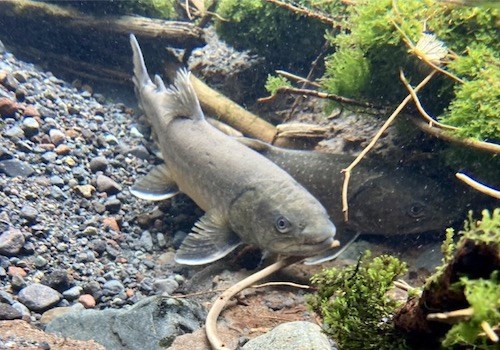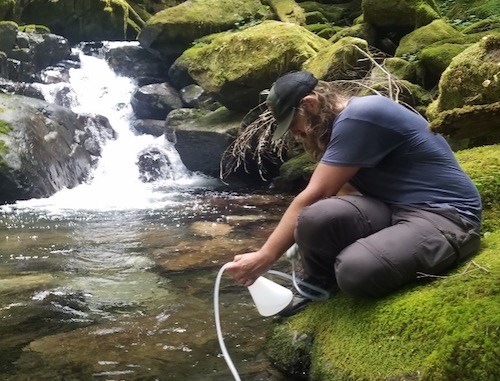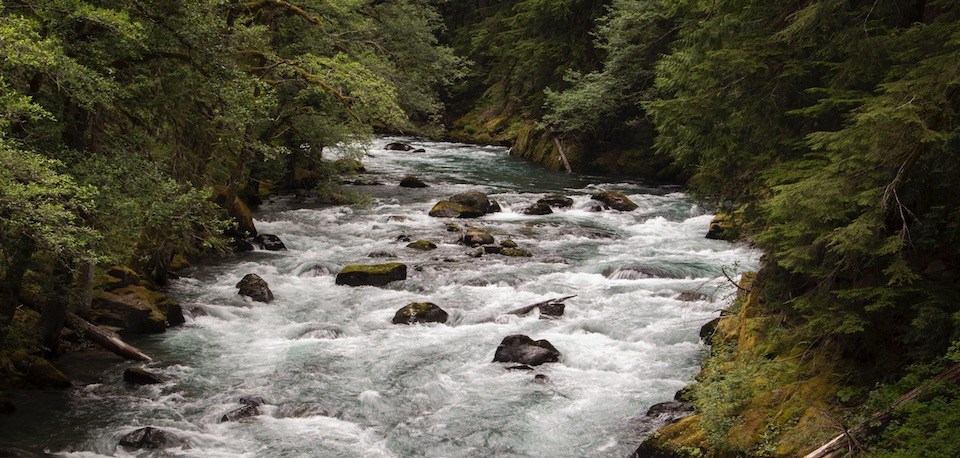Last updated: May 4, 2023
Article
Fish & Amphibian Inventory: Genetic and Environmental DNA (eDNA) Sampling

NPS Photos
Introduction
Mount Rainier National Park is the headwaters of several, complex, cold-water river and lake systems. This glaciated park creates unique aquatic systems heavily influenced by seasonal runoff from glaciers and snowmelt. Fish and amphibian populations naturally occur throughout the park and are good indicators of an ecosystem’s health due to their sensitivity to environmental conditions.
Historically all lakes within the park were fishless and offered safe breeding pools and habitat for the many amphibians. Between 1915 and 1972, over nine million fish were stocked into the lakes and streams within Mount Rainier National Park. Brook trout (Salvelinus fontinalis) and other non-native fish were introduced to the park to improve recreational fishing opportunities. Streams throughout the park and approximately 35 lakes currently support populations of non-native fish. This stocking and expansion of non-native fish may be the greatest potential threat to native fish in the park and are known to reduce or displace native amphibian species of concern and alter ecosystems (Figure 1).

NPS Photo
Bull trout (Salvelinus confluentus) are a federally threatened species of char which can be historically found in cold water stream and lake habitats across northwestern North America, including several drainages in Mount Rainier National Park (Figure 2). But bull trout aren’t the only species of char within the park. Brook trout, their non-native cousins, can hybridize, compete with, and prey on juvenile bull trout. Brook trout have been identified as a threat to the persistence and recovery of bull trout in Mount Rainier National Park. Dolly Varden (Salvelinus malma), another species of char, may be present within Mount Rainier National Park, but are not yet documented.
The low population density and remoteness of these aquatic organisms in the park make biological surveys costly and require a high effort by park staff. Through the sampling of environmental DNA (eDNA) in water, park staff can use this tool to gather a full picture of where fish and amphibians are present in the park. Genetic sampling is another tool to better understand the origins and distribution of fish species present in the park. Appearance alone may not be enough to distinguish a stocked fish from a native fish, or a potential hybrid. With these two methods of aquatic sampling, park staff can better manage and protect aquatic organism populations. The park can understand the distribution of stocked non-native fish and the extent of hybridization of fish which can better inform recreational and conservation management decisions.

NPS Photo
Methods
The two tools the park is utilizing to understand the distribution of aquatics species and fish stocks present are eDNA collection and genetics sampling.
Environmental DNA
- Environmental eDNA or eDNA, is ribosomal DNA that is released from an organism into the environment. Sources of eDNA include feces, mucous, skin, scales, hair, and carcasses. eDNA is extracted from the aquatic environment using a filter attached to a pump which pulls water across the filter (Figure 3). After a set amount of water is filtered, the filter is carefully removed, and stored for later analysis by our lab partners.
- The park is using eDNA to efficiently detect presence/absence of fish and amphibians in watersheds throughout the park. This method can be used to map drainages in which certain species are present, and inform which drainages need more intensive sampling.
Genetic Sampling
- Genetics samples are obtained using multiple sampling methods. Depending on the species, fish may be captured by gillnet, hook and line, or electro-fishing. Once a fish has been captured, a clip is taken from its upper caudal (tail) fin and stored in ethanol until it can be processed (Figure 4). These samples are analyzed to identify the origins of fish (stocked or native), degree of hybridization, life history (resident or anadromous), and further delineate species.

NPS Photo
Project Objectives
- To understand the presence and distribution of aquatic species throughout the park using eDNA.
- To define the population genetic structure and diversity of fish populations in Mount Rainier National Park to facilitate future management strategies.
- To identify the presence or absence of Dolly Varden in the Park.
Results
To date, Mount Rainier National Park technicians have collected twenty-eight eDNA samples. The White River, Puyallup, Mowich, and Carbon River watersheds have been targeted due to their potential overlap of char species.
Park staff have also collected a variety of genetic samples throughout the park from a range of fish species in lakes and streams including bull and brook trout, rainbow and cutthroat trout, and coho salmon.

NPS/E. Brouwer Photo
Looking Ahead
For the 2022 field season, eDNA sampling efforts will continue and expand throughout Mount Rainier National Park. With eighty-nine newly proposed eDNA sampling sites, the park is hoping to expand its knowledge of amphibian and fish species distribution. The Huckleberry Creek, Ohanapecosh, and the Nisqually drainages are the new study areas, focusing on the detection of amphibian species.
We also intend to expand our genetic fish library. Additional char genetic samples will be collected in streams and lakes. Future funding will support the analysis of almost 700 char genetic samples collected throughout the Puyallup watershed by Mount Rainier National Park and other regional partners including the Puyallup Tribe of Indians and U.S. Fish and Wildlife Service. Results will provide a better understanding of the genetic distribution of char within and outside the park, and the extent of hybridization.
The Ohanapecosh drainage is also targeted in 2022 for genetic sampling (Figure 5). Park staff hope to discover the origin of rainbow and cutthroat trout present within the drainage. By clarifying the origin of these fish, park managers can appropriately adjust fishing regulations and management to better conserve native species within the Ohanapecosh.
References
- DeVivo JC. 2019. Inventories 2.0: A plan for the next generation of NPS natural resource inventories. Natural Resource Report. NPS/NRSS/NRR—2019/2007. National Park Service. Fort Collins, Colorado
- National Park Service (NPS). 2017. Mount Rainier Fish Management Plan Environmental Assessment. Mount Rainier, Ashford, WA.
- [USFWS] U.S. Fish and Wildlife Service. 2008. Bull trout (Salvelinus confluentus) 5-year review: Summary and evaluation. U.S. Fish and Wildlife Service, Portland, Oregon.
